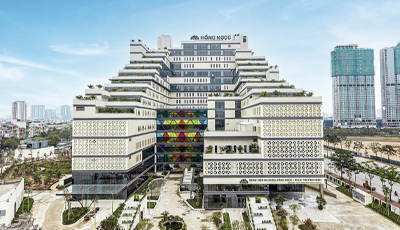HÀ NỘI — Hồng Ngọc General Hospital hosted an international conference on ‘Advancements in Cardiovascular Interventions’, with over 200 cardiologists and experts in attendance on August 10.
This event provided a valuable opportunity for both domestic and international cardiovascular specialists to present and discuss the latest advancements, with the aim of applying these developments in clinical practice, to enhance the quality of care for heart patients and streamline coronary artery intervention procedures, thereby reducing treatment times.
At the conference, seven discussion sessions focused on the latest updates in the management and treatment of cardiovascular diseases, featuring leading experts from South Korea, Taiwan (China) and Việt Nam.
Topics included the use of circulatory support devices in cardiogenic shock, updates on the diagnosis of acute coronary syndromes and more.

The intervention procedure at Hồng Ngọc's Cardiac Catheterisation Lab was broadcast live to the conference room. - Photos of Hồng Ngọc General Hospital
Notably, for the first time in Việt Nam, Professor Dr Ying-Hwa Chen, Director of Structural Heart Disease at the Cardiovascular Centre - Taipei Veterans General Hospital, presented a report on ‘Strategies to Minimise Conduction Disturbances After Transcatheter Aortic Valve Replacement (TAVR) with Self-Expanding Valves Using the Cusp Overlap Technique.’ This is a new technique being presented in Việt Nam for the first time.

Professor Dr Ying-Hwa Chen, Director of Structural Heart Disease at the Cardiovascular Centre - Taipei Veterans General Hospital. - Photos of Hồng Ngọc General Hospital
Dr Ying-Hwa Chen said in an interview: “Nowadays, we use cusp overlap technique, it means we shift the angle of the valve, and overlap the left coronary cusp (LCC), right coronary cusp (RCC) and isolate noncoronary cusp so we can elongate the left ventricular outflow tract we can pay more attention to implant depth of the valve. Therefore, the valve can be implanted in a high position so the valve will not compress to conduction systems like left bundle or right bundle branch block. So we need the technique like conduction disturbance reduces remarkably”.
One of the key highlights of the conference was the focus on the application of drug-coated balloon angioplasty, with a presentation by Associate Professor Dr Lee Joo Myung from the Cardiovascular Stroke Institute at Samsung Medical Centre, Sungkyunkwan University School of Medicine, in Seoul, South Korea

Professor Dr Lee Joo Myung from the Cardiovascular Stroke Institute at Samsung Medical Centre, Sungkyunkwan University School of Medicine. - Photos of Hồng Ngọc General Hospital
The talk provided an update on the latest research into the technical standards for performing drug-coated balloon angioplasty in patients with coronary artery disease who are at high risk of bleeding. This method of treatment is a novel approach that is rapidly gaining traction worldwide.
Dr Lee Joo Myung, on his view, saying: “If the patient is young and has de-novo carotid stenosis which requires percutaneous coronary intervention, you can use drug-coated balloon as the procedure the inherent function of the vessels. And in this case, I personally believe drug-coated balloon angioplasty is much better than implantation of permanent metallic stent”.
At the conference, a live broadcast showcased a procedure using drug-coated balloon angioplasty on a 65-year-old patient with a 90 per cent artery stenosis and a high risk of bleeding. The intervention was performed by Dr Nguyễn Văn Hải, Head of Interventional Cardiology at Hồng Ngọc General Hospital.

Live broadcast of an intervention using drug-coated balloon angioplasty combined with vFFR software for non-invasive coronary flow reserve measurement.
Dr Hải also incorporated the use of vFFR software—a non-invasive coronary flow reserve measurement tool—being implemented for the first time in northern Việt Nam.
The vFFR software represents a significant advancement in vascular intervention, offering a non-invasive alternative to the traditional invasive FFR (Fractional Flow Reserve) method. This innovation allows doctors to accurately identify damaged arteries while minimising the need for invasive equipment, thereby reducing procedure time and enhancing patient safety.
The conference was not only an opportunity for Vietnamese doctors to listen to and learn from in-depth reports, but also a chance for esteemed doctors and experts to network, exchange experiences and engage in discussions about the latest challenges and solutions in the field of cardiovascular intervention. — VNS












